Suzuki GSX-R1000R was the second place finalist at the recent 2017 AMCN AUSTest
Suzuki unleashed its new GSX-R1000 RR on the world at Phillip Island earlier this year with a promise of renewed strength, pride and racetrack domination. A head-to-toe rebuild and the use of some very innovative MotoGP-inspired technology has seen the superbike king claw its way back to competitiveness in the big-bore class. Like the Honda it needed to make a big change, because although last year’s bike was an amazing machine it was still very basic internally.
Finally, Suzuki has joined the 21st-century, fitting all the extras the modern rider expects: an updated IMU6-activated electronics package and ride-by-wire throttle system, a brand-new frame, styling and the fitment of the MotoGP-inspired Suzuki Racing Variable Valve Timing (SRVVT). Suzuki claims it has experienced no failures in 10 years of racing with this new technology and in a world of high-tech it was the right time to bring it into production.
The SRVVT-enhanced engine was a big hit with the AUSTest riders, its raw power still perceptible even with the extraordinary amount of electronic support provided by the new ECU. Alex loved the midrange punch provided by the new system and found the build-up of power to the top end was nothing short of outstanding.
The Suzuki has always been a sweet handling all-rounder and that has not changed in 2017 with the new chassis feeling stable on braking, turn in, and all the way through the corner. It takes slightly more effort to tip in than its AUSTest rivals, but it is heavy in a confidence-inspiring way. There somehow seemed to be an extra support guiding you through the turns and perhaps a little more feel to the tyre that gave the rider complete confidence.
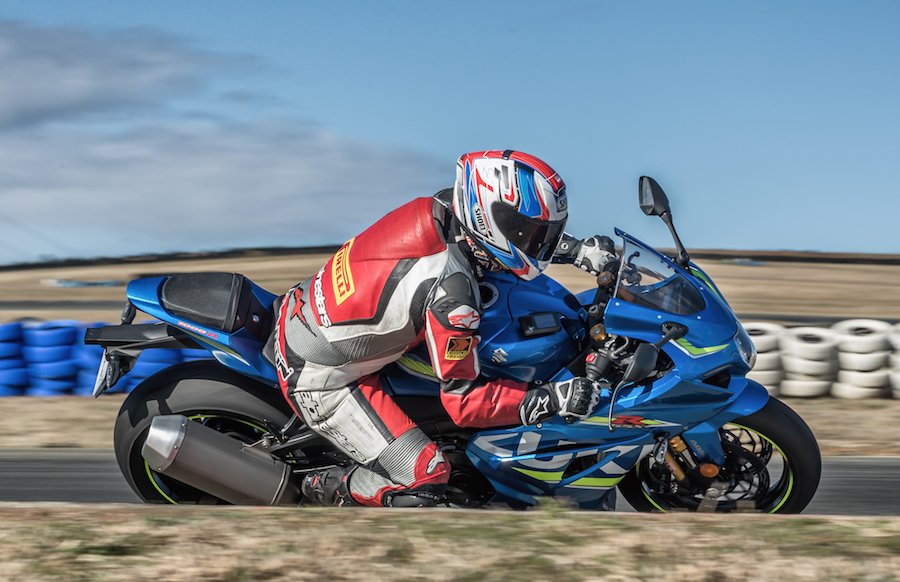
The fitment of the latest Showa BFF fork and BFRC light rear shock is a brave move, but perhaps a smart one for this high-end model. On the track the suspenders performed brilliantly, giving a firm controlled ride with a lack of the harshness associated with racing suspension. The only downfall we discussed was the lack of that magic button that softens the suspension when you turn off the track and hit the road. The Showa system fitted to the Suzuki was one of only two without active suspension, and we wondered how that would play out in the voting.
The new GSX-R is a big improvement on the old bike and the fact that it is such a major overhaul makes that even more impressive; it’s a lot easier to refine an old product than start from scratch. It also makes it exciting, because we are only at the start of the development curve and there is much more scope for further gains. It’s already at the level of the competition in its first year – the Suzuki took the coveted fastest lap award at our track test. And at $25,490 (+ ORC) it was the cheapest of our combatants, giving it a great shot at AUSTest glory.
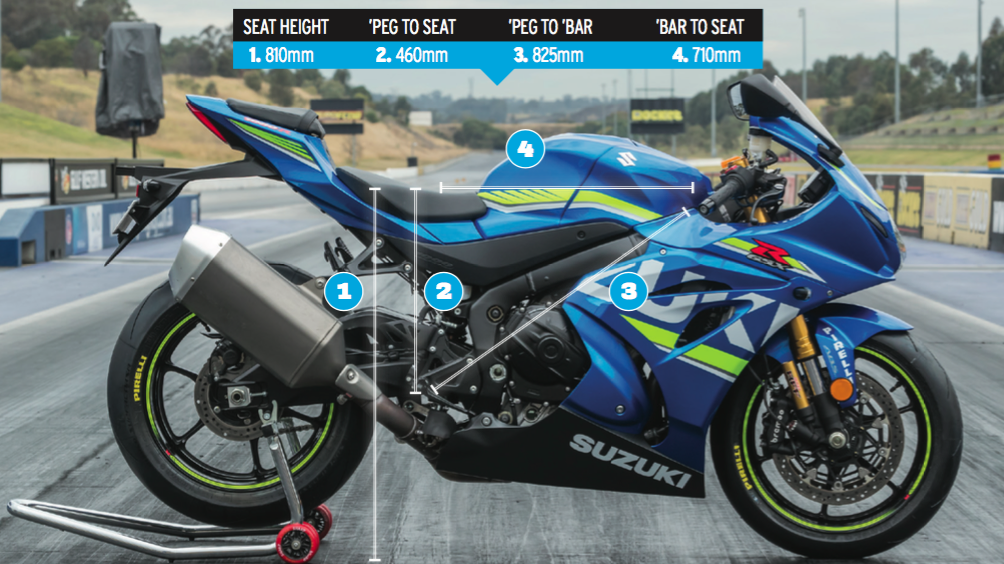
Three things
- Should Suzuki have splashed more cash on the dash? Maybe, but the LCD unit didn’t get any complaints
- The GSX-R was the only bike of the bunch fitted with a Showa BFF fork and BFRC rear shock – and they didn’t disappoint
- Inlets beside the headlight are part of the Ram Air Direct system, claimed to boost performance

Second Ops
Stephanie Redman
The engine was a stand-out for me. The power I know and love from the GSX-R engine hasn’t been drowned out by the electronics – I really felt like I was riding a 1000cc sportsbike!
The bike was very well-balanced, so lap after lap I was able to push later and deeper, and at no stage did I feel I got close to its limits. The brakes had a nice progressive feel to the lever but at the same time had a lot of power right from initial engagement. The front fork and brake combination on the GSX-R is a winner too.
Distance from seat to ’pegs and seat to ’bars suited me well – sporty but not uncomfortable. All the controls were within easy reach and I didn’t have to compromise how I wanted to sit – it was plug and play.

Harley from RB Racing says…
The GSX-R is textbook perfect on the dyno, with no weak spots or dips on the torque curve. The fuelling is near spot-on all the way through, and the transmission is clean and precise. The ride-by-wire throttle has the slightest momentary lag at the first 2% opening at higher rpm, but apart from that, the moment the throttle is turned, the engine gets straight down to business. Suzuki has always been a class leader in producing great power, and this is no exception.
It’s not a surprise that the Suzuki ranked highly in this year’s AUSTest, with its freshness grabbing the attention of everybody who rode it. Its all-new construction won hearts left, right and centre and it was a clear crowd favourite. The GSX-R’s engine characteristics give it a phenomenal feel when you twist the right hand, and it’s hard to get the smile off your face.
Of all the models on test, it’s the one that’s had the most change. It has also benefited greatly from the development of the GSX-RR MotoGP bike, giving the package as a whole a feel of technology and breakthrough. It was fastest on the track and if Gilesy lost a few kilos could have been fastest at the strip too, making us wonder how it didn’t win. But even with all its brilliance it came down to everyday use, and its lack of heated grips, active suspension and cruise control – all offered by the BMW – were too much to overcome.
The fact that Suzuki came so close to winning 2017 AUSTest, missing out by just a couple of points, is pretty impressive when you consider this is just the first generation of the new bike.
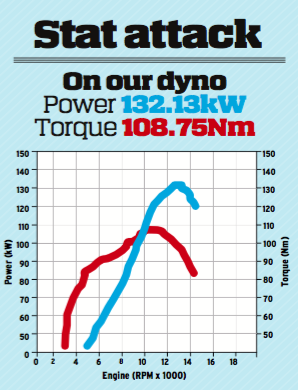

2017 AMCN AUSTest
Once it was the kind of cutting-edge technology you’d find only on MotoGP and WSBK bikes; now electronic assist systems and dynamic suspension are the rule for all big-bore production superbikes, not the exception.
In our last AUSTest, back in 2015, we celebrated the rebirth of the superbike, when the world’s top manufacturers pulled themselves out of the GFC doldrums and got back to work creating proper one-litre speed machines. Bugger the cost, and bugger the practicality they said.
Two years later, the world’s fastest and most desirable machines have morphed once more. With big-bore nakedbikes becoming the machine of choice for the regular rider wanting usable power, handling and looks in a package they can live with day to day, production superbikes have become the Ferraris and Lamborghinis of the motorcycling world. Crammed full of power, performance and electronics few will ever fully test, and riding on a suspension package that can adjust itself on the fly, these machines are gorgeous examples of what is possible, yet are impractical for the road – and that’s why we love them.
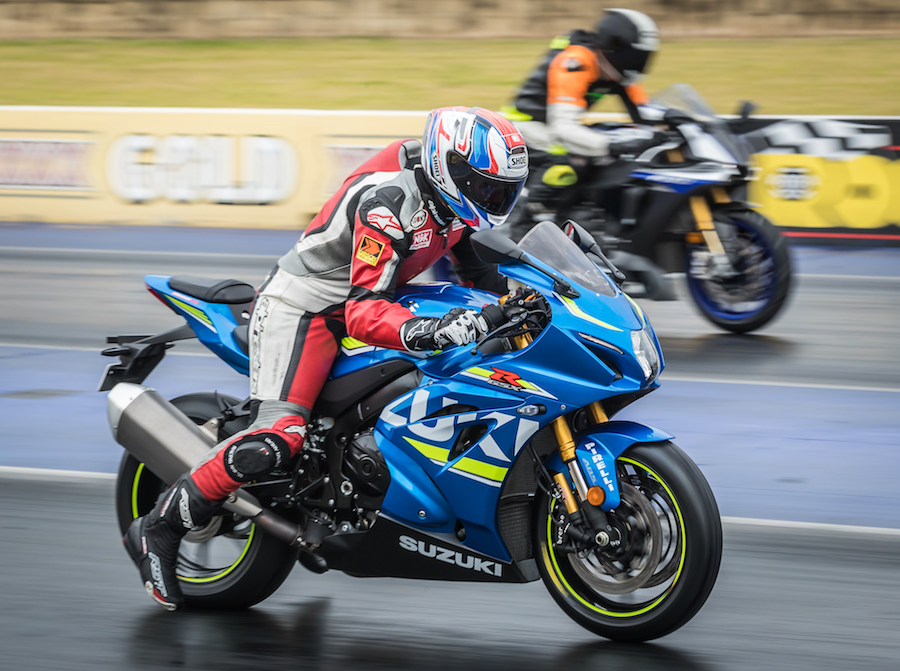
In another first for AUSTest, every bike tested this year sits well over the $20,000 mark. If your five-figure budget begins with a 1, you are out of luck. All that technology comes at a cost, but as you are about to discover, a higher price mostly offers better value for money.
While the evolution of the superbike has continued unabated, one thing returning to the way of old is how we conduct AUSTest. For 2017, we were back in NSW and invited manufacturers to be hands on, requesting each deliver their bike accompanied by a factory-trained technician to help our test riders find the best possible set-up. Such is the high regard the manufacturers have for the AUSTest title, most sent multiple staff and the show looked more like a round of the ASBK than a shootout. That’s fitting, considering our AUSTest combatants often go head to head on the track.
In the end, there can be only one winner, and over the next 26 pages we will take you through the exhausting testing process. Then, when you think you have the winner sussed, we will reveal our champion. Enjoy the ride – we certainly did.
Suzuki GSX-R1000R second place
It’s not a surprise that the Suzuki ranked highly in this year’s AUSTest, with its freshness grabbing the attention of everybody who rode it. Its all-new construction won hearts left, right and centre and it was a clear crowd favourite. The GSX-R’s engine characteristics give it a phenomenal feel when you twist the right hand, and it’s hard to get the smile off your face.
Of all the models on test, it’s the one that’s had the most change. It has also benefited greatly from the development of the GSX-RR MotoGP bike, giving the package as a whole a feel of technology and breakthrough. It was fastest on the track and if Gilesy lost a few kilos could have been fastest at the strip too, making us wonder how it didn’t win. But even with all its brilliance it came down to everyday use, and its lack of heated grips, active suspension and cruise control – all offered by the BMW – were too much to overcome.
The fact that Suzuki came so close to winning 2017 AUSTest, missing out by just a couple of points, is pretty impressive when you consider this is just the first generation of the new bike.

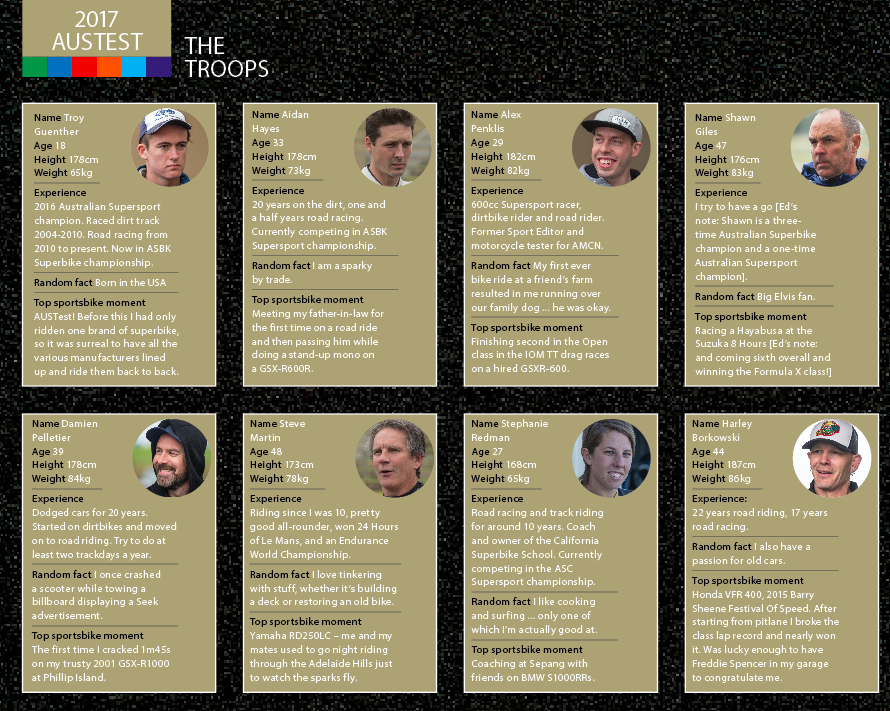
Day 1
Sydney Dragway
It’s a known fact that there’s no quicker way to get away from the lights than to use a machine producing in excess of 130kW and weighing just 200kg. Now, imagine a set of traffic lights where you don’t need to shut the throttle before changing to second gear and obliterating the speed limit. Such a place exists at Western Sydney. With a surface as sticky as shit on a blanket, and electronic timing with reaction times and speed traps, it’s a quarter mile of international-standard heaven that hosts some of the fastest drag bikes and cars in the world.
We lined our six AUSTest combatants up two at a time to test their launch and wheelie control, and of course, to see which could cover the quarter mile distance in the quickest time at the fastest speed. Before getting underway, those in the know said that a low 10-second pass would be impressive.
What eventuated left the experts gobsmacked.
Day 2
Wakefield Park Raceway, Goulburn
A regular stop on the ASBK circuit, Wakefield Park is tight and technical – an evil-handling bike will quickly be found out on the undulating 2.2km circuit. Throw in strong winds and unpredictable weather, and you need to be on the ball.
For a full day we rotated the six AUSTest bikes through the hands of the eight track-test riders. As conditions improved, and the technicians fine-tuned the bikes, the lap times began to drop. While there are no AUSTest points on offer for the fastest lap, there are definitely bragging rights, and everyone wanted them.
We won’t spoil the surprise, but we will say that the lap times set would have seen our stock-standard AUSTest entrants line up mid-grid at an ASBK round. Impressive stuff.
Day 3
Road ride, Goulburn to Sydney
The chosen route was 400km-plus of tight twisty and open country road special stages connected by freeway hops, all packed into a non-stop day. This provided the riders with a chance to sample each bike in the environment where it will be most used. An uncomfortable seating position or snatchy fuelling will always be revealed on a road ride. AUSTest titles have been won and lost in this section of the test.
Day 4
On the dyno
Are the claimed numbers bullshit? There is only one way to find out: with a dyno.
Our final destination for AUSTest 2017 was RB Racing at Caringbah where Harley Borkowski ran each of the bikes on the dynamometer to measure kW and Nm output. Harley was also one of our test riders this year, giving him the unique opportunity to see if the dyno numbers correlated to what the seat of his pants said.
THE METHOD
Who buys a superbike? A snapshot of the current superbike buying public will reveal possibly one of the widest demographics of any genre. Everyone from riders graduating from a restricted licence through to those who have worked long and hard enough to afford a few luxuries in life are buying superbikes. Highly skilled riders and racers buy them, as well as people who just want to look like Messrs Márquez, Rossi and Lorenzo at the local café – and drool over what a production superbike has to offer. AUSTest is as much about real-world performance and looks as it is about race pedigree and lap times, so we assembled a group of riders that represent the broad spectrum of superbike buyers. Daily riders, trackday junkies, endurance champs, national-title winners, professional test riders and young guns presently contesting the national Superbike and Supersport categories all made up the eight-rider test team charged with the task of determining who made the best two-wheeled missile for the best price.
Each rider was given two sessions on each bike on the drag strip, track and the road. Then they were handed an extensive voting form covering everything from how the bike performed and how it made them feel, through to value for money and which bike simply did it for you – regardless
of the cost.
While quarter-mile sprint and track lap times provided an indication of performance as well as plenty of entertainment and all-important bragging rights, it’s the results from the points-based voting sheets that determined the AUSTest 2017 champion.
Tyres
In years past we have experimented with a control tyre for AUSTest. While the idea works in theory, in reality most manufacturers have a commercial agreement with a tyre manufacturer, and the bike is developed using those tyres. If you are a superbike owner keen to cut some serious laps at a trackday, you will be faced with a few brand and rubber compound choices. To simulate a real-world situation, we left tyre choice to the manufacturers. As long as the tyre was DOT approved and available in Australia it was good to go.
Each manufacturer’s choice of tyre for AUSTest is provided on the test results. Most used just the one set of tyres for the drag strip and trackday, reverting to the OEM tyres for the road ride.
Timing
Each bike’s best quarter-mile time and top speed, as well as its fastest lap time on the track, do not form part of the voting criteria for AUSTest 2017, so this information is irrelevant – said no sane motorcycle lover ever. The minute the first bike shot down the quarter mile at Sydney Dragway or turned the first lap at Wakefield Park, everyone had their stopwatch out.
Sydney Dragway has its own timing system, but for Wakefield Park we needed something reliable, easy to install and easy to understand, that provided results instantly. The SpeedAngle lap timer ticked all these boxes. The team from SpeedAngle provided a unit for each bike, and even programmed the name of each model into the system so there could be no mix-ups. All six units performed faultlessly throughout the day, capturing every lap of every session.

It’s not a surprise that the Suzuki ranked highly in this year’s AUSTest, with its freshness grabbing the attention of everybody who rode it. Its all-new construction won hearts left, right and centre and it was a clear crowd favourite. The GSX-R’s engine characteristics give it a phenomenal feel when you twist the right hand, and it’s hard to get the smile off your face.
Of all the models on test, it’s the one that’s had the most change. It has also benefited greatly from the development of the GSX-RR MotoGP bike, giving the package as a whole a feel of technology and breakthrough. It was fastest on the track and if Gilesy lost a few kilos could have been fastest at the strip too, making us wonder how it didn’t win. But even with all its brilliance it came down to everyday use, and its lack of heated grips, active suspension and cruise control – all offered by the BMW – were too much to overcome.
The fact that Suzuki came so close to winning 2017 AUSTest, missing out by just a couple of points, is pretty impressive when you consider this is just the first generation of the new bike.
